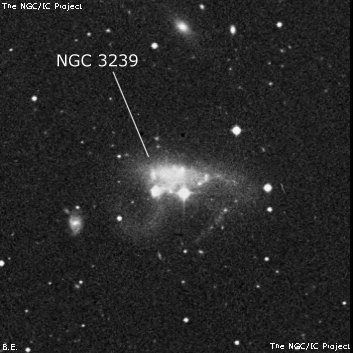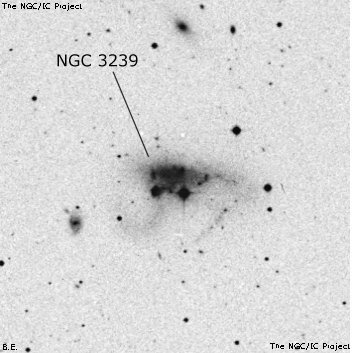NGC/IC Project Restoration Effort
(This is a very very beta version)
NGC3239


Basic Information
Location and Magnitude
Right Ascension: 10:25:5.5
Declination: +17:9:37
Constellation: LEO
Visual Magnitude: 11.3
Historic Information
Discoverer: Herschel W.
Year of discovery: 1784
Discovery aperture: 18.7
Observational
Summary description: vF, * 9 inv nr M
Sub-type: IBm/P
Corwin's Notes
=====
NGC 3239 is a large, nearby, low-surface-brightness, late-type spiral. It is
coincidentally seen on the sky around a 9th magnitude star noted by both WH
and JH (in three different sweeps). I've given the position of the star in
the table as well as that of the galaxy itself.
The galaxy's position is relatively difficult to determine. There is no
nucleus, and the bar is patchy with knots and resolved supergiants. However,
the SDSS image shows a faint peachish haze in the brightest part of the bar
toward the eastern end of the galaxy. This is what is left of the "nuclear
bulge" in a galaxy of this type. I've estimated the position of this bulge on
the DSSR2 image, and have adopted that as the position of the galaxy. There
is a bright complex of HII regions south-southeast of the center of the bar,
and I give a position for that as well.
Finally, a neighboring galaxy, CGCG 094-042, was glimpsed by both Mitchell and
Hunter with LdR's Birr Castle "Leviathan." See the short story on that in the
"notngc" files.
Steve's Notes
=====
NGC 3239
48" (5/4/16): NGC 3239 was examined at 488x, specifically looking for the two tidal tails not seen in the previous observation with Lowrey's 48". A very faint curving tail or hook (identified as "Tail A" in Krienke & Hodge's 1990 paper "The structure of the irregular galaxy, NGC 3239") was seen extending from the very bright HII knot (VV 95b) on the southeast side. It curves clockwise to the southeast in the direction of a mag 15.8 star [2' ESE of the mag 10 superimposed star].
Beyond the west end of the main glow is a fairly wide, very low surface brightness glow (the start of "Tail B") in the direction of a mag 12.5 star (2.4' due W of the bright star); it then sweeps broadly towards the south. A narrow extension heading southwest ends at a faint HII knot, perhaps 6" diameter, which is identified in NED as NGC 3239:[HK83] 75 and 80.
48" (2/19/12): NGC 3239 = Arp 263 is a large, disrupted irregular, dominated by numerous HII regions. It was a fascinating sight at 488x. A mag 10 star is superimposed on the southwest side of the galaxy with the patchy, highly irregular surface brightness glow of the galaxy extending mainly north and east of the star.
A very bright, round knot of ~15" diameter is prominent on the southeast side of the galaxy. This HII complex is catalogued as VV 95b in NED and as region #6 and #10 in Hodge-Kennicutt's 1983 "An Atlas of HII Regions in 125 Galaxies". A faint star or knot is attached on the north side. A "star" recorded just off the west side of this knot turns out to be supernova SN 2012A, discovered on 7 Jan 2012, still currently around 14th magnitude (see image at http://skycenter.arizona.edu/gallery/Galaxies/ngc3239). Very faint haze extends southeast of VV 95b, but the "tail" structure was not seen.
Along the north side of the galaxy (elongated east-west) are several additional knots. About 30" due north of VV 95B is HK[83] #3 and #4. This close pair of knots appeared as a faint, small, irregular glow, ~6" diameter. Patchy haze is just west, but with no condensed spots. Further west, and 40" due north of the mag 10 star, is a moderately bright, small, round knot, ~10" diameter that has several HK[83] entries (#28/29/31/34). To the west of this knot, the glow of the galaxy ends near HK[83] #57/58, a faint low surface brightness knot that is elongated N-S.
18" (3/28/09): moderately bright and large, irregular shape and mottled appearance, elongated ~2:1 E-W, ~1.0'x0.5'. A mag 9.5 star is superimposed on the SW side with the brighter portion of the galaxy extending to the east. On the SW end of the galaxy is a bright HII knot (VV 95B = Hodge-Kennicutt #10) of ~20" diameter. The galaxy has a patchy surface brightness with an ill-defined, irregular halo. A number of fainter galaxies are in the field (background cluster) including CGCG 94-42 2.9' SE, CGCG 94-40 4.8' N, CGCG 94-43 6.3' NNE, UGC 5639 8' NE, CGCG 94-39 8.5' N, CGCG 94-46 8.5' SE.
17.5" (4/13/91): fairly faint, moderately large, elongated 2:1 E-W, very unusual appearance as a mag 9 star (BD+17 2217) is superimposed on the south side. An unusually bright knot is following the bright star by 51" on the SE side of the galaxy. This is possibly an offset nucleus or more likely an HII knot. The galaxy appears to extend to the west from this knot. The galaxy exhibits an irregular surface brightness with edges difficult to define as it fades into the background. The halo is more extensive to the north with averted vision. About 2' NW and 2' W are two mag 11 and 12 stars.



